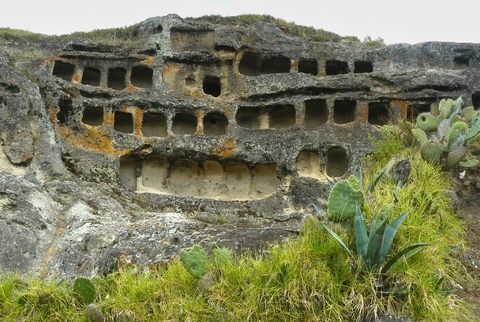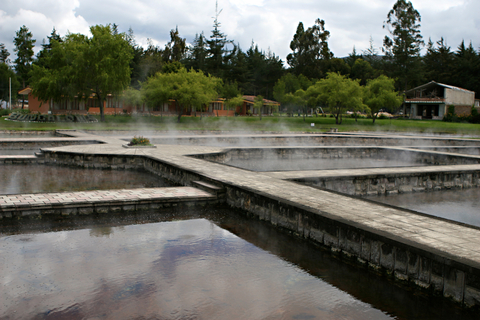Cajamarca

The department of Cajamarca comprises broadly of two different climate zones: the North, consisting of a semi-tropical ecosystem (San Ignacio, Jaén, and Chota Cutervo parts), and the South. It can also be found that the 'islands' are of other ecosystems (jalcas, strong or punas jalcas or wetlands).
Few regions of Peru offer, like this, such diverse environments in such a small area. This is because the climatic belts differ due to changes in altitude.
Cajamarca is the lowest region of the Andes. It's a humid climatic region, with seasonal rains and frequent droughts, so that agriculture has to thrive with the help of irrigation.
The valleys of Jequetepeque are devoted to the cultivation of rice and fruits like mango and avocado, of the highest quality. There are also plenty of livestock.
Its mountains, relatively low in altitude compared to the rest of the country, have been favored with a huge mineral wealth. Not only are there mines of gold, silver and copper, but also molybdenum and tungsten.
Cajamarca was one of the smaller departments of indigenous Quechua. In many provinces the peasants only speak Castilian, as in Chota and Contai. By their distance from Cuzco, the Inca regime ayllu arrived late and failed to reach the critical role it had in the south of Peru.
Access Routes
The distance between Lima and Cajamarca is 856 km which is usually covered in 17 or 18 hours. Following the Panamerican highway past the town of Pacasmayo, in the department of La Libertad (km 683), one finds the turnoff to Cajamarca.
Town of Cajamarca
At the foot of the hill Cumbe, and at the bottom of a huge valley, the valley with the largest planted area of the country, lies the historic town of Cajamarca, more Spanish than Indian, rising up from the belfries and towers carved in white stone.
The luxurious finish of its colonial buildings and the haughty aristocratic lines make this city the most Spanish of all cities of Peru, preserved almost intact over time.
At an altitude of 2750 meters, its mild and sunny climate belies the etymology of its indigenous name Casamarca, "open region" or "cold region", as some scholars would say.
Considered the birthplace of the Peruvian-because it was here, on November 16, 1532, that the historic meeting between the Spanish conquistadors and the Incan civilization occurred. After the execution of the Incan, Atahualpa in the square in 1533, the city of Cajamarca became the stronghold of the army of conquest, from which it radiated to all parts of Peru conquering the rest of the country and imposing the rule of the king of Spain.
Churches and Mansions
Cajamarca's churches are among the most beautiful of Peru and South America, and just as remarkable are its architectural wealth of carved altars.
Many of them have no towers or truncated design. The explanation is that the crown of Spain issued a grant to the religious order that had a church under construction and, once finished, the religious order was ordered had to pay a tax to the crown.
As it was considered that the construction of a church was concluded with the completion of its towers, they were not well finished off, and never received permanent orders on this.
Sights
Ransom Room
Located near the main square is the only Inca building that has survived in Cajamarca.
According to traditional versions, the Inca Atahualpa offered to fill this chamber of thick blocks (7 m long, 6 m wide and 3 m high) once with gold and twice with silver, in exchange for his life. Hence it's name, the Ransom Room.

INCA BATHS
In an idyllic landscape, 6 km southeast of the city of Cajamarca, are located the hot springs and medicinal pools called "Baños del Inca". It was here that the Inca Atahualpa came when he was surprised by the Spanish invaders.
This water source “termo medicinales" is considered one of the most important in the country's north. In pre-Hispanic times, it was known as Pultumarca spa.
Due to the ease of access to the facilities and the beautiful landscape today, the Inca Baths are visited by an average of a thousand people a day.
The thermal waters of the Inca Baths make their way through the earth's crust at various points, raising plumes of steam that can be seen from a distance. Its main sources are 'The Perolitos "and" Laguna Seca "
The hot spring spa includes a number of "eyes" where water is abundant in spurts, after which it is held in 8 ponds bordered by concrete and stone paths, which are at a height of about one meter above the water surface.
In addition, through aqueducts, thermal water "The Perolitos' is conducted into 20 bathing pools with private rooms for 2 people maximum and concrete pools for 6. To regulate its high temperature it is mixed with cold water from the spring ¨Santa Rosa¨, which is in the vicinity.
The hot springs of Baños del Inca, have been recommended for the treatment of rheumatic diseases and chronic nerve problems.


